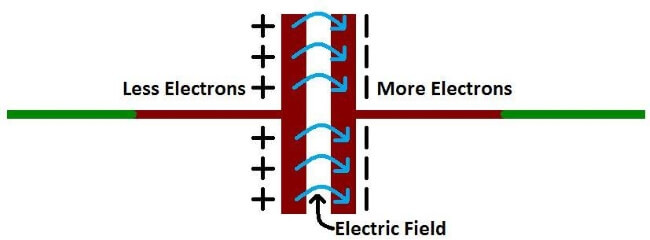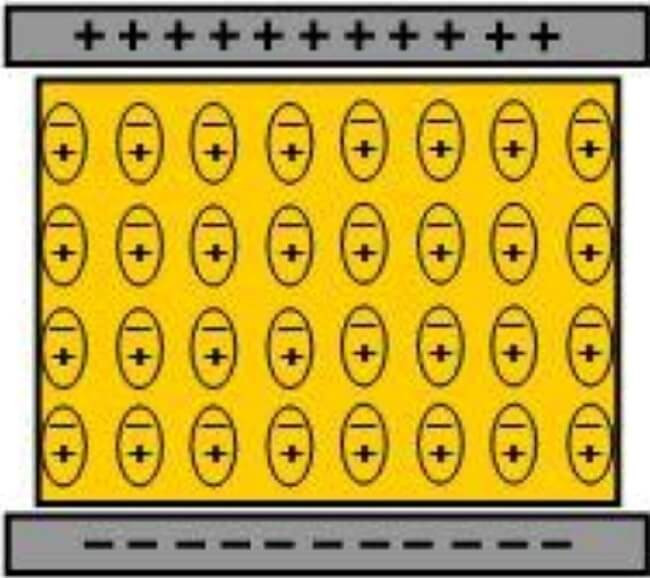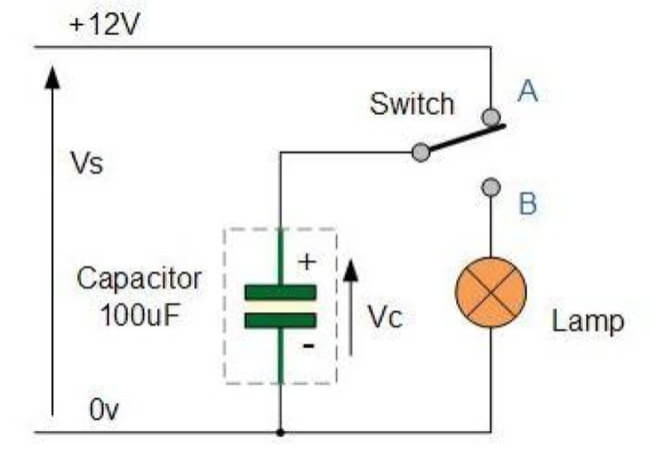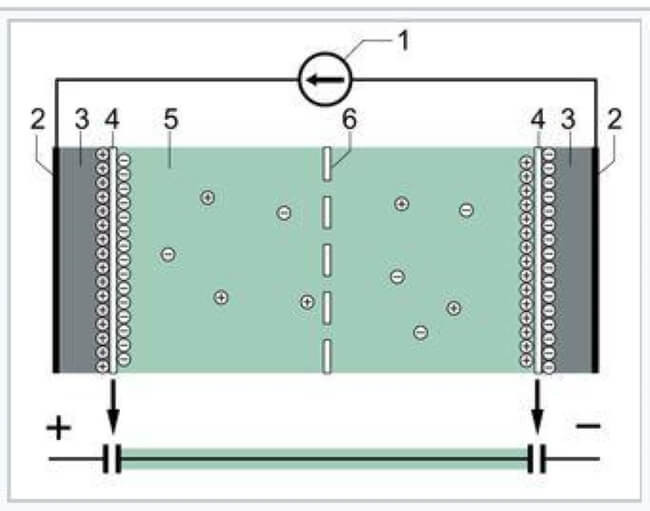6 Things You Need to Know About Supercapacitors
Articles | 22-10-2019 | By Gary Elinoff
The most basic type of capacitor is simply two parallel electric plates. If a battery is connected to this capacitor, the battery’s negative terminal will push electrons onto one plate, making it negatively charged. The positive battery terminal will draw an equal number electrons away from the plate it is attached to, making it positively charged.

The simplest possible capacitor
The empty space between the plates prevents the excess electrons on one side from jumping across to the positive side. Instead, they stay where they are, and an electric field is generated, going from the positively charged plate to the negatively charged plate, which stores an amount of electric energy equal to the amount of charge that the battery gave up.
The charge of an electron can be defined in terms of a unit defined as a COULOMB. In fact, A single electron has a charge of 1.60217733 × 10-19 coulombs
The definition of Capacitance (C) is Charge (Q, or coulombs) divided by Voltage (V, or voltage).
The unit of capacitance is the FARAD.
C = Q/V
So, we can see that the capacity of a capacitor, defined in farads, is the amount of charge it can hold for a given amount of voltage applied to its plates.
1- What Is the Purpose of a Dielectric in a Capacitor?
The capacity of a capacitor is proportional to the area of the plates and their separation. The purpose of the dielectric is to increase the capacitance, C = Q/V, without increasing the size of the plates or changing their separation. Here’s how it works.
A dielectric is a material the does not conduct electricity that can be placed between the two plates of the simplest capacitor described earlier. When the battery is attached, the result is that the atoms in the dielectric are distorted, with the negative parts of the atom pulled towards the positive plate of the capacitor, and the positive parts of the atom attracted to the negative plate.

Credit: School Physics
These “reverse voltages” serve to reduce the voltage between the plates of the capacitor, by cancelling the contributions made by some of the charge from the battery. But the battery will keep on dumping charge into the capacitor until the voltage on the plates is equal to the voltage of the battery.
So, the voltage on the plates is the same as before, but with the addition of the dielectric, more charge is absorbed. Since C = Q/V, with the same voltage and more charge, the value C for capacitance is increased
2- How do Capacitors Store Electrical Energy?
In the circuit below, with the switch in position “A”, the capacitor charges as before.

Credit: Electronics Tutorials
When the switch is moved to position “B”, the stored charge flows through the lamp, causing it to generate light up until the charge is used up. As such, a capacitor can serve as an energy reservoir, storing electrical energy, from whatever source, for use at a later time.
3- What exactly is a Supercapacitor?
A supercapacitor is has a far higher rating in “farads” than do any other type. As such, it can store far more energy. In the example of the last section, if a supercapacitor was used instead of an ordinary type, it could have stored far more charge, and could have powered the lightbulb for a proportionally longer time.
One type of supercapacitor is the electrostatic double-layer capacitor, diagrammed below. There are the usual plates separated by an ionic electrolyte.

Credit: Wikipedia
The biggest difference is that while the positive plate still attracts negative ions and the negative plate attracts positive ions, the formulation of the device is such that they form what is called a Helmholtz double layer, reference #4 in the diagram. The positive ions, separated from the negative ions by less than a nanometer, effectively form a “pseudo” capacitor, one on the positive plate, and one on the negative plate. From our vantage point outside the device, it’s like two capacitors in series.
Because the closeness between the plates is a factor defining farad value of a capacitor, the fact that there is less than a nanometer separation between the “plates” of the two pseudocapacitors means that the capacitance of these devices are huge. A supercapacitor can be rated at as many as a million times as many farads as the device in section 2.
The bottom line is that a supercapacitor can store a far, far greater amount of energy.
4- What is the difference between Power and Energy?
The words “power’ and “energy” are often used interchangeably, but there is a huge difference, as power is correctly defined as the amount of energy available per unit time.
Power = Energy/Time
In the picture below, let’s think of water as power. The bottle on the right holds far more water than does the cup on the left, so it can be said to hold more energy. But, while the cup on the left holds less water, it can supply far more water than the bottle can in a given amount of time.

Credit (modified): Energy Education
5- How do the Energy and Power Densities of Batteries and Supercapacitors Compare?
A supercapacitor of a given weight cannot store nearly as much energy as a lithium-ion battery can. However, a supercapacitor can discharge far faster than a battery can.
Thus, the supercapacitor compares to the cup in the previous illustration, while the battery compares to the bottle.
So while a supercapacitor (at present) cannot be used to power a car for hundreds of kilometres like a battery can, there are power application where a supercapacitor can serve.
-
Supercapacitors are being used to power buses in Chinese cities. They can go for about 15 km before needing a charge, which takes about 5 minutes. While this wouldn’t be useful for general automotive purposes, it is entirely practical for an urban bus route.
-
Supercapacitors can also be used to power the robots used in automated warehouses. This is eminently practical because the robot will never be far from a point where it can be automatically recharged.
-
Because wearable devices are designed to work with very low power, supercapacitors are a natural for their use in such applications.
6- Why are Supercapacitors and Batteries Important Partners?
A most obvious pairing is for regenerative breaking in electric vehicles. When an EV (electric vehicle) needs to stop, what is essentially an electrical generator is electrically coupled to the wheel. The energy of the vehicle’s forward motion is converted to electricity, slowing it to a halt.
A battery’s power density is too small to absorb all that energy in the time frame within which the vehicle must stop – but a supercapacitor, with its enormous power density, can do the trick. Then, the energy now stored in the supercapacitor can be transferred back into the battery at the more leisurely pace that the battery’s lower power density can handle.
With conventional breaking, that forward momentum is not only wasted but converted into vehicle-damaging heat. With regenerative braking, a hallmark of EV’s, the forward momentum of the vehicle is instead returned to the battery, where it can be used once again to power the vehicle when the light turns green.

